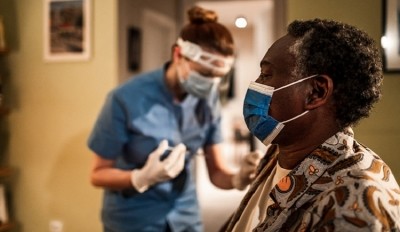Art contest aims to build awareness of clinical trial opportunities

Clinical research participation could possibly use a boost—with many studies struggling to hit enrollment targets, trial teams often seek out ways to build awareness of research opportunities and reach potential patients. The Bridging the Gap for Clinical Trials contest, a free-to-enter artistic competition offering cash prizes for winning entries, seeks to employ creative expression to increase awareness of clinical trial opportunities.
To learn more about the contest, Outsourcing-Pharma connected with two leaders with organizer SiteBridge Research:
- Johanne Laboy, head of community engagement
- Nancy Sacco, head of clinical operations
OSP: What in a nutshell is the Bridging the Gap for Clinical Trials program?
JL: The Bridging the Gap for Clinical Trials Arts competition is a community-facing opportunity that employs the power of the arts to educate, raise awareness, and generate conversation about clinical trials, and diversity in clinical trial participation.
OSP: How did the idea come about?
JL: During a corporate retreat, when we were discussing how we could design, develop, and implement innovative and ground-breaking community engagement efforts to educate and entertain at the same time, Allison Kalloo, co-founder of i-Participate, an art lover, and one of our consultants, suggested involving the arts in the process. We all enthusiastically welcomed and developed the idea, as our entire team is a proponent of the arts.
OSP: Could you please tell us about SiteBridge and your mission to elevate patient experience—what tools, techniques, and technology do you incorporate to work toward that goal?
NS: As a startup, SiteBridge comprises a small, yet dedicated team that, combined, has more than 100 years of experience in the clinical trial space. We are community-oriented and improving health outcomes for racial and ethnic minorities, and underserved populations is our main goal.
Our committed to excellence and success staff is our number one tool. We are intentionally building a team that represents the communities we serve and is genuine about intentions to increase access to medicine for those who do not have these opportunities.
We aspire to be present where the communities we serve could benefit the most from the services we provide. In terms of technology, through our SiteBridge Clinical/Site Development Operations function we have contracted to implement some of the best and most advanced platforms/training materials in the space: CRIO, Qualio, and the AVOCA Knowledge Center.
We are now working on additional technology and patient support such as eConsent, direct-to-patient compensation, and visiting home nurse care. With these technologies and site/patient support in place, we have focused on bringing down the barriers to clinical research participation and improving the process for both sites and participating patients.
Additionally, we are committed to making sure that patient-facing technology is accessible and clinical site activities are managed by culturally competent CRCs that effectively and efficiently guide the physicians and the patients/participants through the clinical study process.
OSP: How does this competition fit in with that mission?
JL: Our Community Engagement department is on a mission to develop, maintain, and sustain meaningful, long-lasting relationships in the communities we serve, and build trust along the way. We are also aiming to ensure that the voices of individuals, patients, and study participants are heard before, during, and after studies are conducted. The competition serves as a venue for the community members to express themselves and inform and educate others in the process.
OSP: Then, please tell us about the categories and qualifications.
JL: Registration is free and anyone, ages 18 and older, can submit entries to the contest’s three categories – visual arts, music, and the spoken word. The qualifying entries in each category can win prizes ranging from $500-$2,000. Those interested in participating must adhere to one of four different themes: personal experience, improved health outcomes, impact on family, friends, or community, and access to medicine.
OSP: Could you please tell us about the DEPICT Act, DIVERSE Act, and Cures 2.0 Act, and how these bills might help?
JL: We are encouraging interested contest participants to exercise their public activism to move three current bi-partisan bills through Congress that each promotes diversity in clinical trials.
Historical inequities in health and research among racial and ethnic minorities need to be addressed. The Diverse and Equitable Participation in Clinical Trials (DEPICT) Act would require enhanced data reporting on clinical trial demographics and provide resources, like workshops and grants, to improve access to clinical trials.
The Diversifying Investigations Via Equitable Research Studies for Everyone (DIVERSE) Act is important legislation for underrepresented populations to seek better health outcomes through access and education about clinical trials. It would also allow the US Department of Health and Human Services (HHS) to issue grant funding or contracts to organizations in the support of increasing education, community outreach, and recruitment for clinical trials.
The Cures 2.0 Act is legislation focused on increasing the speed of delivering groundbreaking, new – and potentially lifesaving – cures, treatments, and innovations to communities most in need. The act would create a new agency aimed at ending difficult diseases – like cancer, diabetes, ALS, Alzheimer’s, and others.
OSP: Do you have anything to add?
JL: It is important to understand that diversity in clinical trials is critical because individuals of different ages, races, and ethnicities may respond differently to the same medical products. We want to ensure that medications and treatments that are developed work well for as many of us as possible. When they don’t, then that improves data for understanding alternatives that should/need to be developed that are effective for diverse groups.
Developing these medications and alternative treatments necessitates the participation of diverse populations. A big thank you to all of those individuals from diverse racial/ethnic backgrounds who participate in clinical trials and help make effective medications and treatments a reality for all.




















